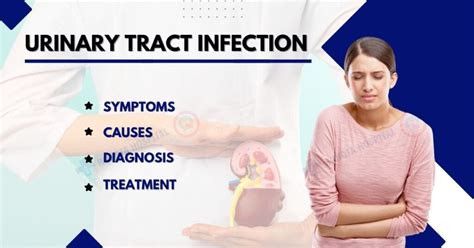Intro
Identify 7 UTI symptoms, including burning sensations, frequent urination, and abdominal pain, to recognize urinary tract infections and seek timely treatment, alleviating discomfort and preventing complications like kidney damage and recurrent infections.
Urinary tract infections, commonly referred to as UTIs, are a prevalent health issue affecting millions of people worldwide. The symptoms of UTIs can vary from mild to severe and can significantly impact an individual's quality of life. Understanding the symptoms of UTIs is crucial for early detection, diagnosis, and treatment. In this article, we will delve into the common symptoms of UTIs, their causes, and what you can do to manage and prevent them.
UTIs occur when bacteria enter the urinary tract, which includes the kidneys, bladder, and urethra. The infection can affect any part of the urinary system, but the most common area affected is the bladder. Women are more prone to UTIs due to their shorter urethra, which allows bacteria to easily enter the bladder. However, men can also develop UTIs, especially as they age. Recognizing the symptoms of UTIs is essential for seeking medical attention and preventing complications.
The symptoms of UTIs can be uncomfortable and disruptive to daily life. If you are experiencing any of the following symptoms, it is essential to consult a healthcare professional for proper diagnosis and treatment. UTI symptoms can range from mild to severe and may include frequent urination, burning sensation while urinating, cloudy or strong-smelling urine, and pelvic pain. Understanding these symptoms is crucial for managing the infection and preventing future occurrences.
Understanding UTI Symptoms

UTI symptoms can be categorized into two main types: lower urinary tract symptoms and upper urinary tract symptoms. Lower urinary tract symptoms affect the bladder and urethra, while upper urinary tract symptoms affect the kidneys. Common lower urinary tract symptoms include dysuria, which is a burning sensation while urinating, frequent urination, and hematuria, which is the presence of blood in the urine. Upper urinary tract symptoms may include flank pain, nausea, and vomiting.
Lower Urinary Tract Symptoms
Lower urinary tract symptoms are the most common type of UTI symptoms. These symptoms can be uncomfortable and disrupt daily life. Some common lower urinary tract symptoms include: * Dysuria: a burning sensation while urinating * Frequent urination: needing to urinate more often than usual * Hematuria: the presence of blood in the urine * Nocturia: needing to urinate during the night * Urgency: feeling the need to urinate immediatelyUpper Urinary Tract Symptoms

Upper urinary tract symptoms affect the kidneys and can be more severe than lower urinary tract symptoms. Some common upper urinary tract symptoms include:
- Flank pain: pain in the side or back
- Nausea and vomiting: feeling queasy or vomiting
- Fever: having a high temperature
- Chills: feeling cold or shivery
- Malaise: feeling unwell or tired
Managing UTI Symptoms
Managing UTI symptoms is crucial for reducing discomfort and preventing complications. Some ways to manage UTI symptoms include: * Drinking plenty of water to help flush out bacteria * Urinating when you need to, rather than holding it in * Avoiding certain foods or drinks that can irritate the bladder * Taking over-the-counter pain relievers to reduce discomfort * Applying heat to the lower abdomen to reduce painCauses of UTI Symptoms

UTI symptoms are caused by bacteria entering the urinary tract. The most common type of bacteria that causes UTIs is Escherichia coli (E. coli). Other types of bacteria, such as Klebsiella pneumoniae and Staphylococcus saprophyticus, can also cause UTIs. Factors that increase the risk of developing UTIs include:
- Being female
- Having a history of UTIs
- Using certain types of birth control
- Having a weakened immune system
- Having an underlying medical condition, such as diabetes
Preventing UTI Symptoms
Preventing UTI symptoms is crucial for reducing the risk of developing UTIs. Some ways to prevent UTI symptoms include: * Drinking plenty of water to help flush out bacteria * Urinating when you need to, rather than holding it in * Avoiding certain foods or drinks that can irritate the bladder * Wiping from front to back after using the bathroom * Avoiding using scented soaps or bubble bathsTreatment Options for UTI Symptoms

Treatment options for UTI symptoms typically involve antibiotics to kill the bacteria causing the infection. The type and duration of antibiotic treatment depend on the severity of the UTI and the type of bacteria causing the infection. In some cases, other treatments, such as pain relievers or urinary tract analgesics, may be prescribed to help manage symptoms.
Complications of UTI Symptoms
If left untreated, UTI symptoms can lead to complications, such as: * Kidney damage: the infection can spread to the kidneys and cause damage * Sepsis: the infection can spread to the bloodstream and cause a life-threatening condition * Recurrent UTIs: if the infection is not fully treated, it can recur * Pregnancy complications: UTIs can increase the risk of pregnancy complications, such as preterm labor and low birth weightConclusion and Next Steps

In conclusion, UTI symptoms can be uncomfortable and disruptive to daily life. Understanding the symptoms, causes, and treatment options for UTIs is crucial for managing the infection and preventing complications. If you are experiencing any symptoms of a UTI, it is essential to consult a healthcare professional for proper diagnosis and treatment.
We invite you to share your thoughts and experiences with UTI symptoms in the comments below. Have you ever had a UTI? What were your symptoms, and how did you manage them? Your feedback and insights can help others who may be experiencing similar issues.
What are the common symptoms of a UTI?
+The common symptoms of a UTI include dysuria, frequent urination, hematuria, nocturia, and urgency.
How can I prevent UTI symptoms?
+You can prevent UTI symptoms by drinking plenty of water, urinating when you need to, avoiding certain foods or drinks that can irritate the bladder, wiping from front to back after using the bathroom, and avoiding using scented soaps or bubble baths.
What are the treatment options for UTI symptoms?
+Treatment options for UTI symptoms typically involve antibiotics to kill the bacteria causing the infection. The type and duration of antibiotic treatment depend on the severity of the UTI and the type of bacteria causing the infection.
Can UTI symptoms lead to complications?
+Yes, if left untreated, UTI symptoms can lead to complications, such as kidney damage, sepsis, recurrent UTIs, and pregnancy complications.
How can I manage UTI symptoms?
+You can manage UTI symptoms by drinking plenty of water, urinating when you need to, avoiding certain foods or drinks that can irritate the bladder, taking over-the-counter pain relievers to reduce discomfort, and applying heat to the lower abdomen to reduce pain.
